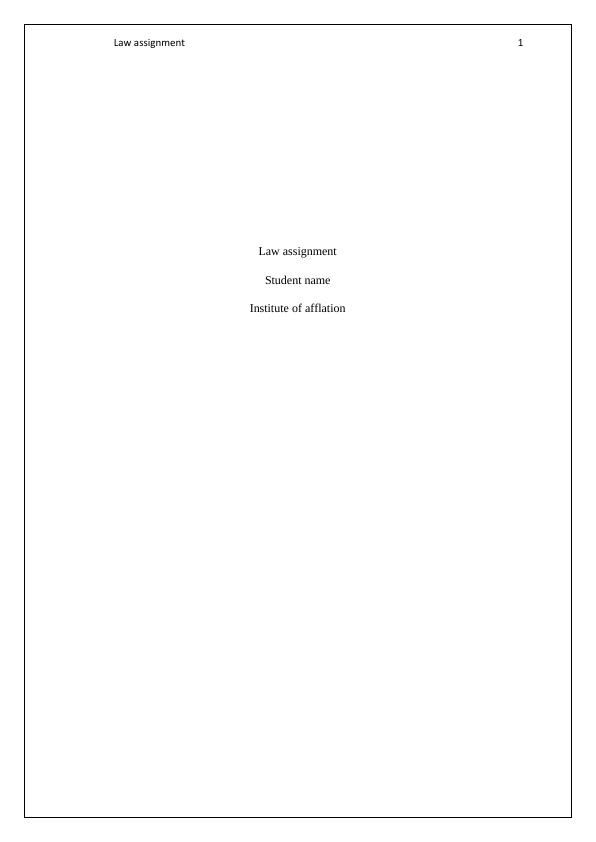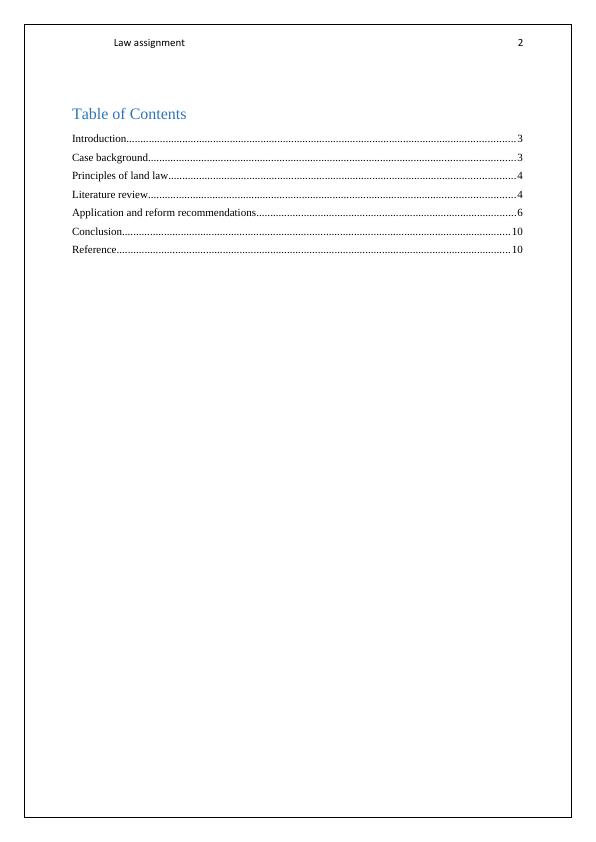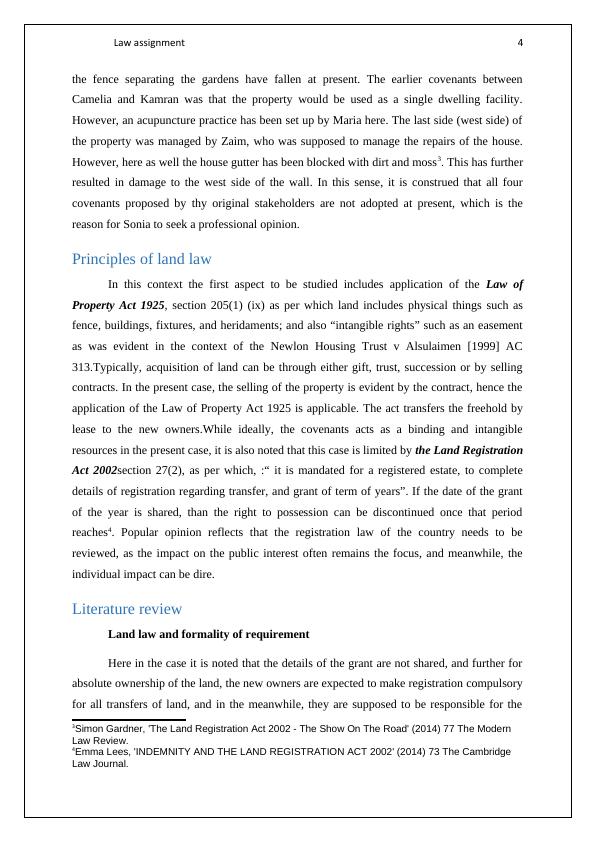Law assignment.
Added on 2023-01-16
13 Pages4474 Words47 Views
Law assignment 1
Law assignment
Student name
Institute of afflation
Law assignment
Student name
Institute of afflation

Law assignment 2
Table of Contents
Introduction...........................................................................................................................................3
Case background...................................................................................................................................3
Principles of land law............................................................................................................................4
Literature review...................................................................................................................................4
Application and reform recommendations.............................................................................................6
Conclusion...........................................................................................................................................10
Reference.............................................................................................................................................10
Table of Contents
Introduction...........................................................................................................................................3
Case background...................................................................................................................................3
Principles of land law............................................................................................................................4
Literature review...................................................................................................................................4
Application and reform recommendations.............................................................................................6
Conclusion...........................................................................................................................................10
Reference.............................................................................................................................................10

Law assignment 3
Introduction
This case uses the principals of English Land Law that focuses on the property
situated at England and Wales. This law is based on the principals of the law of Property Act
1925, and the Settled Land Act 1925. Other aspects considered in this model include the
Trusts of Land and Appointment of Trustees Act 1996 and the 2002 Land Registration Act
2002.Through the land law, this paper addresses issues about the ownership of land, equitable
and legal ownership, tangible andintangible hereditaments of the land, and the concept of
enforceability of covenant.
As in the present case, the focus of the research will be to decipher the third parties’
rights in land and whether the covenants or easement imposed during original ownership are
impacted by the third-party rights. In this sense, the focus of the land law is to ensure that the
transfer of land is completed safely, and through, thus protecting the rights of the buyer and
the purchaser. The focus of the paper is to scrutinize the case scenario and then identify the
issues faced by varied third-party stakeholders1. The paper will assess the enforceability of
previous covenants made by the previous owner, and assess their implications on the present
purchasers. The case, will review thecurrent law and propose the needs of reform for the
Land law. The paper will further deduce the importance of formality requirements and
distinguish between legal and equitable interests in terms of the case scenario to provide
recommendations to the plaintiff.
Case background
A freehold property owned by Camilla with a large manor house was partitioned by
her into four plots (North Side, South Side, East Side and West Side). While Camelia lived in
the South Side; the North Side was sold to Stacey; the East Side to Kamran and the West Side
to Zaim. As all four houses were sold, Xenia purchased the North Side; Maria purchased the
East Side, Zoe purchased the West Side and Sonia purchased the South Side of the plot and
house2.
Earlier the covenant between Camelia and Stacey entailed that there will be a picket
fence to be erected and maintained by Stacey between her garden and Camelia'. However,
1Joseph Warren, 'The Law Of Property Act, 1922' (1923) 21 Michigan Law Review.
2I. L. L., 'Real Property—Vendor And Purchaser—Implied Right Of Way—Rectification Of Conveyance
—Law Of Property Act, 1925, S. 62' (1930) 4 The Cambridge Law Journal.
Introduction
This case uses the principals of English Land Law that focuses on the property
situated at England and Wales. This law is based on the principals of the law of Property Act
1925, and the Settled Land Act 1925. Other aspects considered in this model include the
Trusts of Land and Appointment of Trustees Act 1996 and the 2002 Land Registration Act
2002.Through the land law, this paper addresses issues about the ownership of land, equitable
and legal ownership, tangible andintangible hereditaments of the land, and the concept of
enforceability of covenant.
As in the present case, the focus of the research will be to decipher the third parties’
rights in land and whether the covenants or easement imposed during original ownership are
impacted by the third-party rights. In this sense, the focus of the land law is to ensure that the
transfer of land is completed safely, and through, thus protecting the rights of the buyer and
the purchaser. The focus of the paper is to scrutinize the case scenario and then identify the
issues faced by varied third-party stakeholders1. The paper will assess the enforceability of
previous covenants made by the previous owner, and assess their implications on the present
purchasers. The case, will review thecurrent law and propose the needs of reform for the
Land law. The paper will further deduce the importance of formality requirements and
distinguish between legal and equitable interests in terms of the case scenario to provide
recommendations to the plaintiff.
Case background
A freehold property owned by Camilla with a large manor house was partitioned by
her into four plots (North Side, South Side, East Side and West Side). While Camelia lived in
the South Side; the North Side was sold to Stacey; the East Side to Kamran and the West Side
to Zaim. As all four houses were sold, Xenia purchased the North Side; Maria purchased the
East Side, Zoe purchased the West Side and Sonia purchased the South Side of the plot and
house2.
Earlier the covenant between Camelia and Stacey entailed that there will be a picket
fence to be erected and maintained by Stacey between her garden and Camelia'. However,
1Joseph Warren, 'The Law Of Property Act, 1922' (1923) 21 Michigan Law Review.
2I. L. L., 'Real Property—Vendor And Purchaser—Implied Right Of Way—Rectification Of Conveyance
—Law Of Property Act, 1925, S. 62' (1930) 4 The Cambridge Law Journal.

Law assignment 4
the fence separating the gardens have fallen at present. The earlier covenants between
Camelia and Kamran was that the property would be used as a single dwelling facility.
However, an acupuncture practice has been set up by Maria here. The last side (west side) of
the property was managed by Zaim, who was supposed to manage the repairs of the house.
However, here as well the house gutter has been blocked with dirt and moss3. This has further
resulted in damage to the west side of the wall. In this sense, it is construed that all four
covenants proposed by thy original stakeholders are not adopted at present, which is the
reason for Sonia to seek a professional opinion.
Principles of land law
In this context the first aspect to be studied includes application of the Law of
Property Act 1925, section 205(1) (ix) as per which land includes physical things such as
fence, buildings, fixtures, and heridaments; and also “intangible rights” such as an easement
as was evident in the context of the Newlon Housing Trust v Alsulaimen [1999] AC
313.Typically, acquisition of land can be through either gift, trust, succession or by selling
contracts. In the present case, the selling of the property is evident by the contract, hence the
application of the Law of Property Act 1925 is applicable. The act transfers the freehold by
lease to the new owners.While ideally, the covenants acts as a binding and intangible
resources in the present case, it is also noted that this case is limited by the Land Registration
Act 2002section 27(2), as per which, :“ it is mandated for a registered estate, to complete
details of registration regarding transfer, and grant of term of years”. If the date of the grant
of the year is shared, than the right to possession can be discontinued once that period
reaches4. Popular opinion reflects that the registration law of the country needs to be
reviewed, as the impact on the public interest often remains the focus, and meanwhile, the
individual impact can be dire.
Literature review
Land law and formality of requirement
Here in the case it is noted that the details of the grant are not shared, and further for
absolute ownership of the land, the new owners are expected to make registration compulsory
for all transfers of land, and in the meanwhile, they are supposed to be responsible for the
3Simon Gardner, 'The Land Registration Act 2002 - The Show On The Road' (2014) 77 The Modern
Law Review.
4Emma Lees, 'INDEMNITY AND THE LAND REGISTRATION ACT 2002' (2014) 73 The Cambridge
Law Journal.
the fence separating the gardens have fallen at present. The earlier covenants between
Camelia and Kamran was that the property would be used as a single dwelling facility.
However, an acupuncture practice has been set up by Maria here. The last side (west side) of
the property was managed by Zaim, who was supposed to manage the repairs of the house.
However, here as well the house gutter has been blocked with dirt and moss3. This has further
resulted in damage to the west side of the wall. In this sense, it is construed that all four
covenants proposed by thy original stakeholders are not adopted at present, which is the
reason for Sonia to seek a professional opinion.
Principles of land law
In this context the first aspect to be studied includes application of the Law of
Property Act 1925, section 205(1) (ix) as per which land includes physical things such as
fence, buildings, fixtures, and heridaments; and also “intangible rights” such as an easement
as was evident in the context of the Newlon Housing Trust v Alsulaimen [1999] AC
313.Typically, acquisition of land can be through either gift, trust, succession or by selling
contracts. In the present case, the selling of the property is evident by the contract, hence the
application of the Law of Property Act 1925 is applicable. The act transfers the freehold by
lease to the new owners.While ideally, the covenants acts as a binding and intangible
resources in the present case, it is also noted that this case is limited by the Land Registration
Act 2002section 27(2), as per which, :“ it is mandated for a registered estate, to complete
details of registration regarding transfer, and grant of term of years”. If the date of the grant
of the year is shared, than the right to possession can be discontinued once that period
reaches4. Popular opinion reflects that the registration law of the country needs to be
reviewed, as the impact on the public interest often remains the focus, and meanwhile, the
individual impact can be dire.
Literature review
Land law and formality of requirement
Here in the case it is noted that the details of the grant are not shared, and further for
absolute ownership of the land, the new owners are expected to make registration compulsory
for all transfers of land, and in the meanwhile, they are supposed to be responsible for the
3Simon Gardner, 'The Land Registration Act 2002 - The Show On The Road' (2014) 77 The Modern
Law Review.
4Emma Lees, 'INDEMNITY AND THE LAND REGISTRATION ACT 2002' (2014) 73 The Cambridge
Law Journal.

End of preview
Want to access all the pages? Upload your documents or become a member.